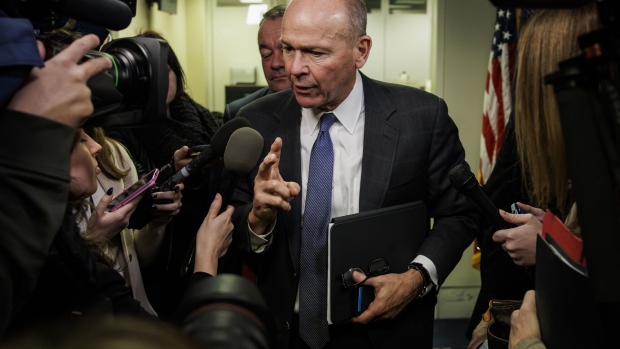Jan 31, 2024
Boeing Pulls 2024 Guidance, Signaling Safety Comes First
, Bloomberg News

(Bloomberg) -- Boeing Co.’s leader offered a public mea culpa as the planemaker detailed its response to a string of quality lapses that culminated in a near-catastrophic panel blowout on a 737 Max.
“We caused the problem,” Chief Executive Officer Dave Calhoun said Wednesday on a conference call to discuss quarterly earnings. While an investigation into the root cause of this month’s accident is underway, he emphasized that the ultimate responsibility rested with Boeing.
The comments highlight how management is downplaying financial results and shifting focus to the efforts to resolve safety issues. In a break from tradition, Boeing declined to give an earnings forecast as its jet-production plans remain uncertain.
“While we often use this time of year to share or update our financial and operational objectives, now is not the time for that,” Calhoun told employees in a memo. “We will simply focus on every next airplane while doing everything possible to support our customers, follow the lead of our regulator and ensure the highest standard of safety and quality in all that we do.”
The CEO used the conference call to outline the path forward as the Federal Aviation Administration steps up scrutiny of its manufacturing and supplier systems. New FAA chief Michael Whitaker has capped 737 production at current levels until quality improves, and vowed to aggressively expand oversight at all of Boeing’s factories.
The National Transportation Safety Board is probing the cause of the blowout, which took place Jan. 5 on Alaska Airlines Flight 1282. Calhoun said he expects the investigation to “narrow quickly” and conclude “in relatively short order.”
Boeing’s shares climbed over the course of the call, reaching a high of 6.6% in New York, the biggest intraday gain since July 26. It was a much-needed rebound for the stock, which had tumbled 23% this year through Tuesday, the worst performance among the 30-member Dow Jones Industrial Average.
Fourth-quarter earnings, cash flow and revenue all surpassed analysts’ expectations, based on results published by the US planemaker. But the report took a back seat to the Max crisis and its response to the ensuing regulatory clampdown.
Investors have long been accustomed to poring over Boeing’s financial metrics and annual targets, with swings in its cash generation reverberating through its shares following results. The fourth-quarter report is particularly key for Boeing as the planemaker typically puts forth an annual forecast for cash flows and deliveries of its two most important products, the 737 Max and the 787 Dreamliner.
Now Boeing is asking them to be patient, with so much at stake as customers, regulators and lawmakers in Washington demand Calhoun take meaningful steps to address the spate of manufacturing shortfalls that have cropped up in the post-Covid era.
“The full ramifications of the latest Max safety issues have yet to be felt, and we see it as telling that Boeing has not provided any update on its outlook or guidance in this morning’s release,” analyst Robert Stallard of Vertical Research Partners told clients Wednesday. “Its immediate fate is arguably in the hands of the FAA.”
In his message to employees, Calhoun emphasized the need to enlist workers in its bid to re-establish quality.
“Our people on the factory floor know what we must do to improve better than anyone,” Calhoun said, encouraging staff to raise issues that need addressing. “We will go slow, we will not rush the system and we will take our time to do it right.”’
Fourth Quarter
The strong close to 2023 provided a glimpse of Boeing’s expectations for a pivotal 2024 prior to the Alaska Airlines accident. The company’s commercial aircraft division posted its first operating profit since the start of 2019, when the 737 Max was grounded globally following two fatal crashes.
For the fourth quarter, Boeing reported an adjusted loss of 47 cents a share, compared to the 76-cent loss expected by analysts, based on data compiled by Bloomberg. Revenue of $22 billion was better than the $21.1 billion predicted by Wall Street. Free cash flow was $2.95 billion, also surpassing the $2.09 billion estimate.
Boeing did provide an important clue for narrowbody production, a linchpin to its finances. The planemaker confirmed that it is building the 737 family of jets at a rate of 38 aircraft a month, in line with previous guidance, and will remain at that pace until the FAA is satisfied with the progress it’s made in improving quality.
This level of output, augmented by Boeing working down a stockpile of previously manufactured jets from inventory, could generate more than 100 additional Max deliveries this year, beyond the 2023 total, according to Ken Herbert, an analyst with RBC Capital Markets.
“If they could actually produce and deliver in the mid- to high-30s, that’s a positive,” Herbert said in an interview. “That potentially gets you above 500 Max for the year.” He expects Boeing to step up handovers of already-built jets, especially with China back in the market for US passenger planes.
(Updates to recast first paragraph, add new details throughout)
©2024 Bloomberg L.P.


